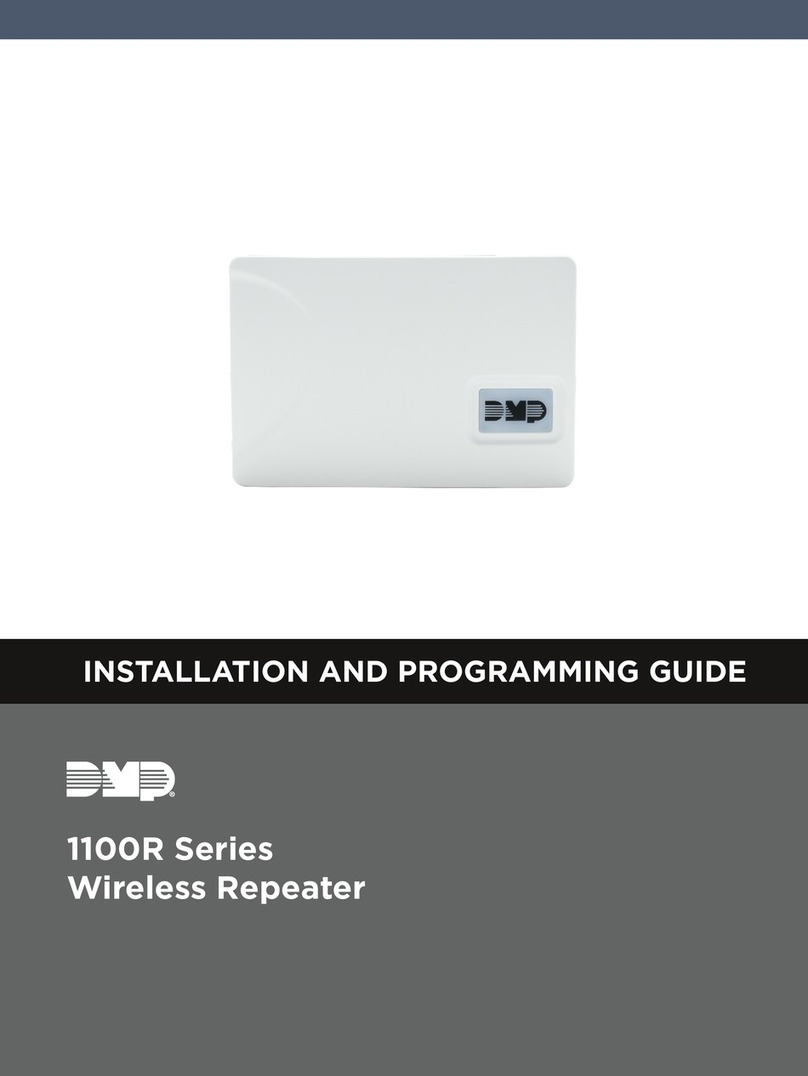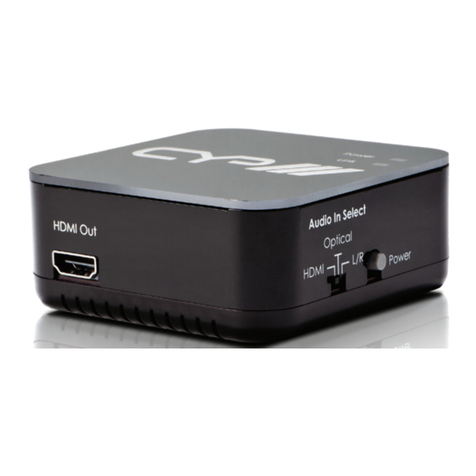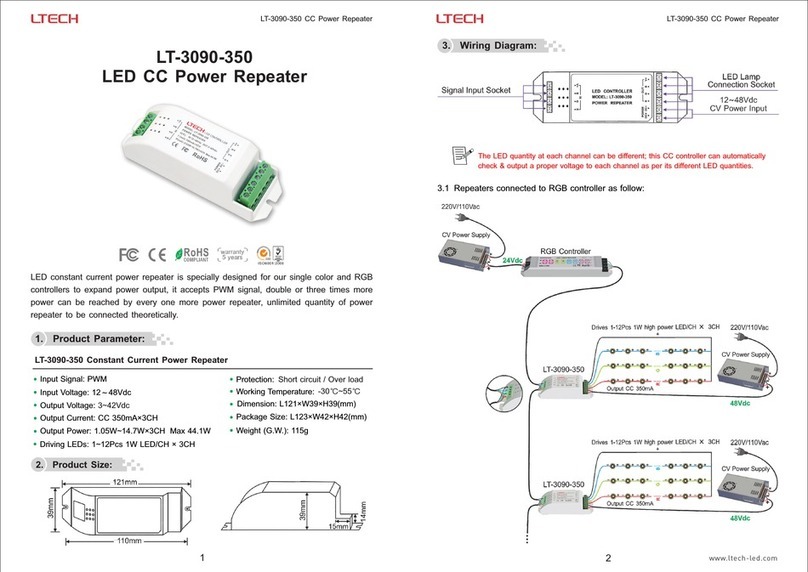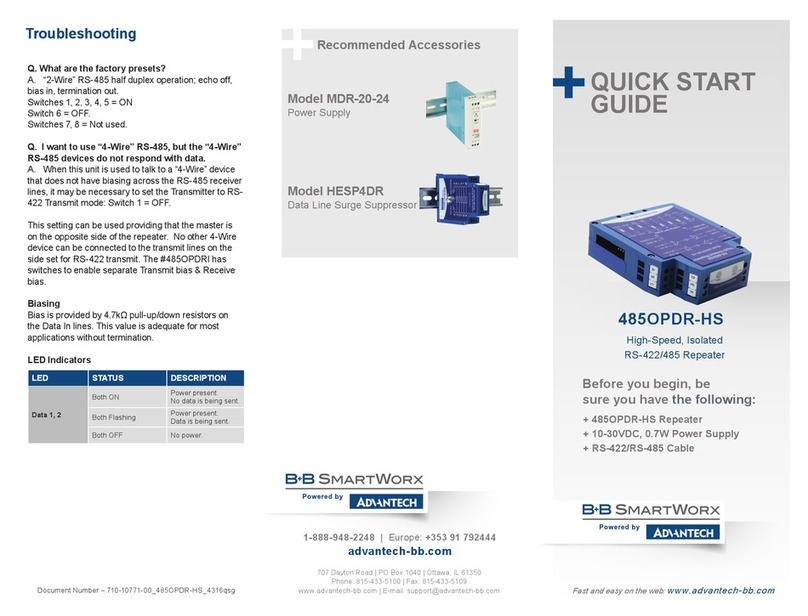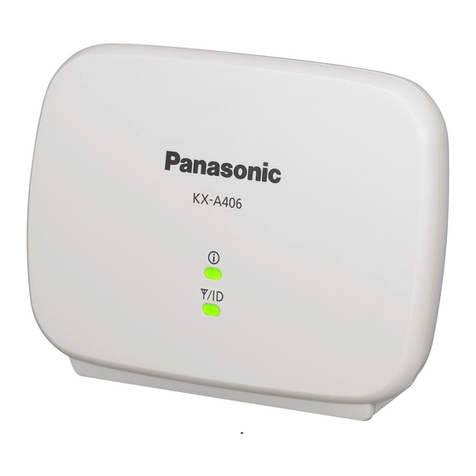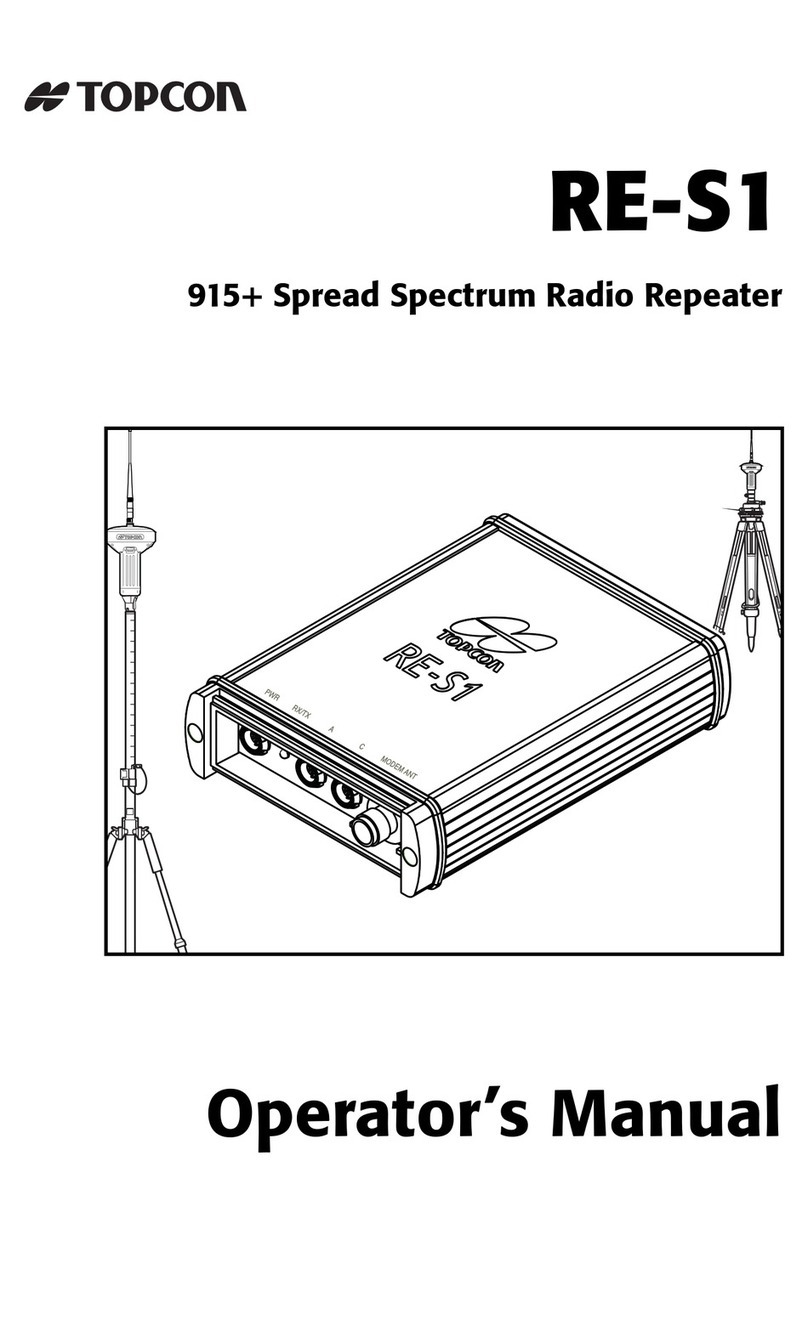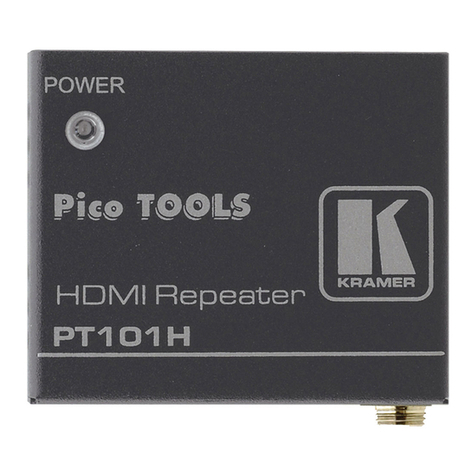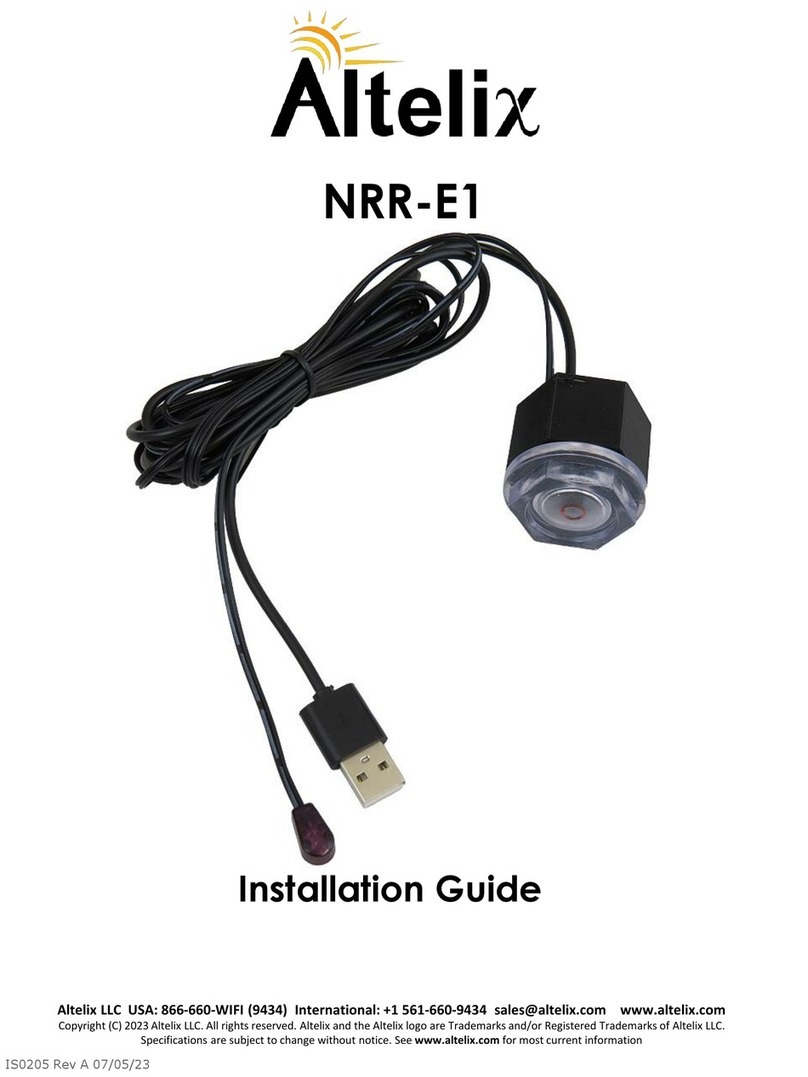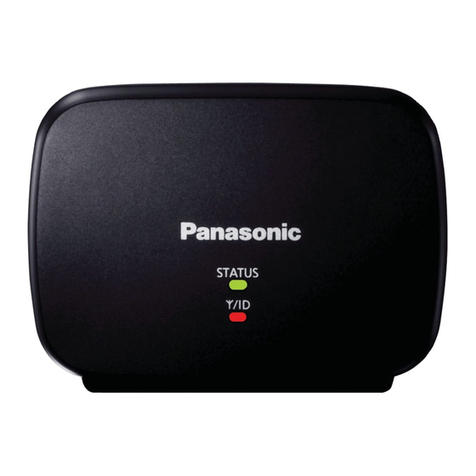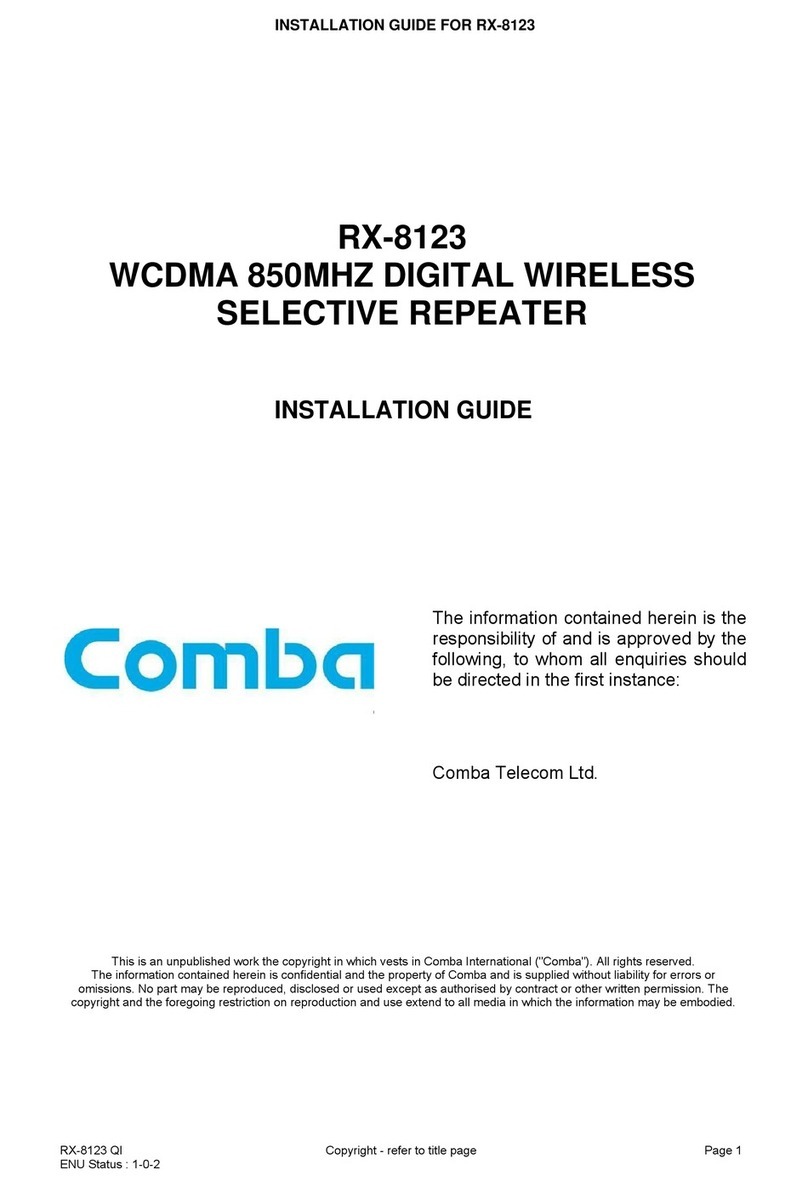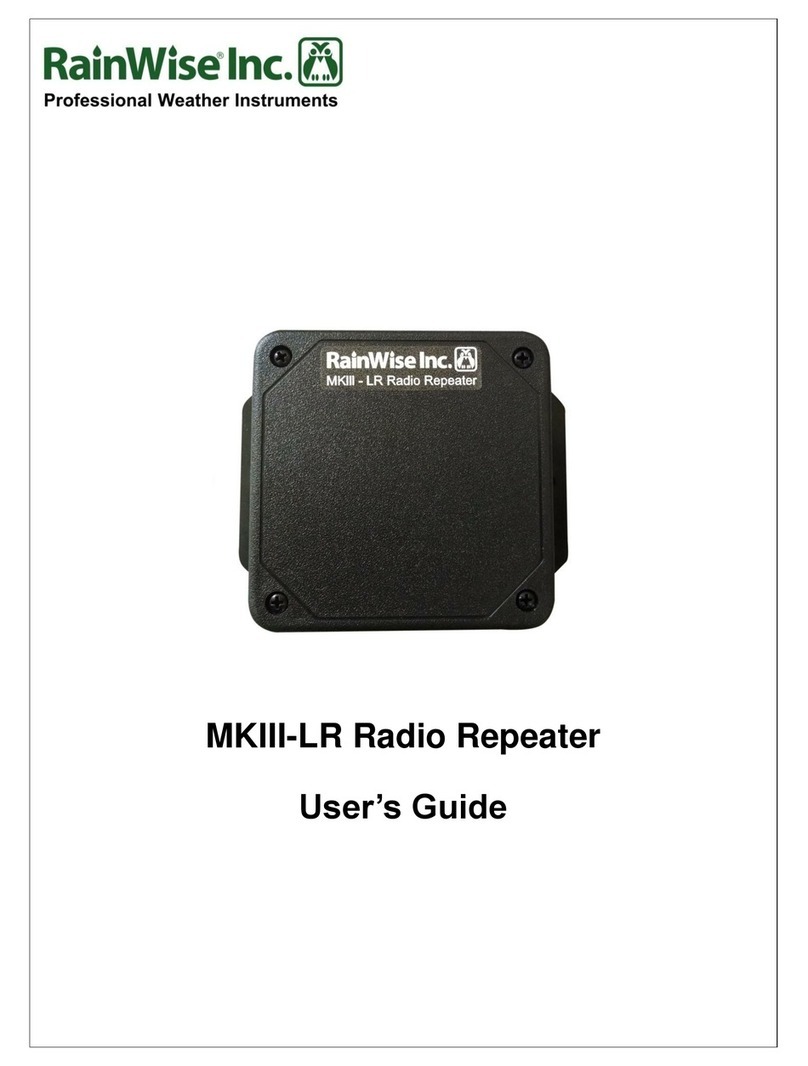Bentel VRP-433 User manual

NOTE: Use these instructions in conjunction with the installation manual of the alarm panel with which this
equipment is intended to be used.
WARNING: READ and SAVE These Instructions! Follow All WARNINGS AND INSTRUCTIONS specified
within this document and/or on the equipment.
VRP-433
Installation Instructions, Instructions d’installation, Instrucciones de Insta-
lación, Instruções de Instalação, Istruzioni di installazione

SAFETY INSTRUCTIONS for VRP433 WIRELESS REPEATER
IMPORTANT:
This equipment, VRP-433 WIRELESS REPEATER 1.0, shall be installed and used within an
environment that provides the pollution degree max 2 and overvoltages category II NON
HAZARDOUS LOCATIONS, indoor only. The equipment is FIXED and DIRECT PLUG IN powered
from the mains; it is designed to be installed by Service Persons only; Service Person is defined as a
person having the appropriate technical training and experience necessary to be aware of hazards to
which that person may be exposed in performing a task and of measures to minimize the risks to that
person or other persons.
1. The equipment is installed in a FIRE ENCLOSURE.
2. If during the installation a knockout is removed, it is the installer's responsibility to ensure that
the same degree of protection for the enclosure is provided by the use of bushings, fittings, etc.
3. The enclosure must be secured to the building structure before operation.
4. Internal wiring must be routed in a manner that prevents:
• Excessive strain on wire and on terminal connections
• Loosening of terminal and connections
• Damage of conductor insulation
5. The end-user and/or installer are responsible for ensuring that the disposal of the used batteries
(battery pack) is made according to the waste recovery and recycling regulations applicable to
the intended market.
WARNING: When using equipment connected to the MAINS, always follow basic safety instructions.
Refer to the SAFETY INSTRUCTIONS provided with this product; save them for (future) reference.
Instruct the end-user regarding the safety precautions that shall be observed when operating this equipment.
SAFETY precautions required during installation:
• NEVER install this equipment during a lightning storm!
• NEVER touch uninsulated wires or terminals unless the direct plug in transformer has been dis-
connected.
• Ensure that cables are positioned so that accidents cannot occur. Connected cables must NOT be
subject to excessive mechanical strain.
• Use only the power supply provided with this equipment. Use of unauthorized power supplies
may damage the VRP-433.
• The AC socket/outlet powering the equipment shall be located near the equipment and shall be
easily accessible.
• Do NOT locate this product where persons will walk on the secondary circuit cable(s).
• Do NOT use extension cords to plug in the power supply of this equipment.
• AVOID setting up the equipment near heaters, air conditioners, ventilators, and/or refrigerators
• Do NOT connect to electrical outlets on the same circuit as large appliances.
• Do NOT select a place exposed to direct sunlight, excessive heat, moisture, vapors, chemicals or
dust.
• Do NOT install this Equipment near water. (e.g., bath tub, wash bowl, kitchen/laundry sink, in a
wet basement, or near swimming pool, etc.).
• Do NOT install this equipment and its accessories in areas where there is a risk of explosion.
• Do NOT connect this equipment to electrical outlets controlled by wall switches or automatic
timers; avoid interference sources.
WARNING:
THIS EQUIPMENT HAS NO MAINS ON/OFF SWITCH. THE PLUG OF THE DIRECT PLUG-IN POWER
SUPPLY IS INTENDED TO SERVE AS THE DISCONNECTING DEVICE IF THE EQUIPMENT MUST
BE QUICKLY DISCONNECTED. IT IS IMPERATIVE THAT ACCESS TO THE MAINS PLUG AND
ASSOCIATED MAINS SOCKET/OUTLET IS NEVER OBSTRUCTED.

Table of Contents/ Table des mati è res/ Índice/ Indice dei contenuti
Installation Instructions.............................................................................................2
Instructions d’installation .......................................................................................10
Instrucciones de Instalación....................................................................................22
Instruções de Instalação..........................................................................................34
Istruzioni di installazione........................................................................................46
The VRP-433 is compatible with the following BENTEL SECURITY wireless devices:
NOTE: VRP-433 is not compatible with 2-way devices.
Door/ Window Contact Alarm Panel
AMC30
AMC10 ABSOLUTA serie
KYO320
KYOUNIT serie
Motion Detector Wireless Receiver
AMD20
AMD20NP VRX32-433
VECTOR/RX8
VECTOR/QUAD
Wireless Key Smoke Detector
ARC20 ASD20

1
Specifications
• Temperature range: -10°C to +55°C (14°F-131°F)
• Humidity (Max): 5% - 93% R.H. non-condensing
• Battery type: Rechargeable Ni-MH, 4.8V/2.1 AH
Replace battery every 3-5 years
• Battery backup time: 24 hours
• Battery charging rate: 80% within 24 hours
• Battery charging current: 170mA
• Operating frequency: 433.92 MHz
• Dimensions: H6.96, W4.47, D1.33 in.
(H17.68, W11.35, D3.38 cm)
• Weight: .77 lb. (.35kg)
Transformer requirements:
Plug-In Class II power limited transformer (fused)
Primary: 120VAC, 60Hz, 0.2A (International Market. Acceptable to the local authorities)
230VAC, 50Hz, 0.1A (International Market. Acceptable to the local authorities)
Secondary: 16VAC-18VAC, 20VA
The following plug-in transformer shall be used:
PTD1620T-EU, CE approved 230V/16.5V 20VA
Maximum allowed wire run distances:
AWG Feet Meters
24 5.8 1.8
22 9.3 2.8
20 14.8 4.5
18 23.5 7.2

2
The VRP-433 is a wireless repeater designed to extend the range of BENTEL SECURITY
one-way wireless transmitters and to improve signal quality between the transmitter and
receiver. Use the VRP433 to remedy transmission problems caused by excessive noise or other
interference, or by long distances between devices and receivers. The maximum recommended
number of VRP-433’s per alarm system is 4.
Each enrolled VRP-433 occupies a zone slot. The VRP-433 does not increase the number of
supported wireless zones. This is determined by the control panel’s wireless receiver. Only zones
requiring repeat functionality need to be enrolled on the VRP-433. Ensure these zones are enrolled on
both the VRP-433 and the receiver/control panel.
Unpacking
Ensure your package includes the following:
Controls and Indicators
Table 1: LED Definitions
Introduction
• One VRP-433 (rechargeable Ni-MH battery included)
• One direct plug-in transformer (Not included in all configurations)
• Mounting hardware pack, including plastic wall plugs and screws
• Installation instructions
The VRP-433 has three LEDs on the front. The
meaning of these LEDs is different when in
normal operational mode (cover on) than when
in Installer mode (cover off). See the table
below for descriptions of LED functionality.
The wall tamper must be closed for the LEDs
to operate.
Figure 1: LED Indicators
LED Normal Mode (cover on) LED Installer Mode (cover off)
Green On: AC present
Flashing: No AC, battery good
Off: No AC and dead battery
Green 1 flash: Enrolled
Flashing: Placement test active
Red On: Battery not connected
Off: Battery good (if AC on)
Flashing: Low battery
Red Flashing: Zone not enrolled
Yellow On: RF jam present
Off: No RF jam Yellow On: Repeater placement test “bad”
Off: Repeater placement test “good”
Flashing: Sporadic interference or valid
transmission packets detected
Green Yellow
Red
X
X

3
Install the VRP-433 in the following order.
NOTE: When enrolling and placement testing the VRP-433 with the alarm panel, refer to the
compatible control panel installation instructions for the appropriate programming sections.
Step 1: Temporarily Mounting the VRP-433
Select a suitable location for the VRP-433. Use the following list as a guide:
• Locate device near a power outlet
• Location should be free from vibration and shock
• Mount on a flat, stable surface
• Ideal location is mid-way between the wireless transmitter and receiver. The minimum distance
between the VRP-433 and the receiver should be no less than 1 meter (3.28 feet)
Do not permanently mount the VRP-433 until it has been placement tested. Temporarily
mount the unit using tape or other non-permanent, non-marking method. If the selected
location fails the placement test, the device must be repositioned.
Step 2: Connecting Power
Connect back-up battery first then AC.
To connect the battery:
1. Gently open front cover using small slotted screwdriver in holes provided (see Figure 3).
2. Attach battery cable to connector on PC board.
The VRP-433 includes a Programming button
used to place it into Enroll/Placement modes.
A 4-position DIP switch is also provided to set
the following options:
The default for all switches is ON.
Figure 2: Internal Controls
Installation
Table 2: DIP Switch Settings
Switch ON OFF
1 Wall tamper enabled Wall tamper
disabled
2 RF Jam notification
not sent to receiver RF Jam
notification sent
to receiver
3 Compatible with
VRX32-433
receivers
Compatiblewith
future receivers
4 For installations
with 1 VRP-433 For installations
with Multiple
VRP-433 ’s
Programming
Button
X
DIP Switch

4
Depending on the charge state of the battery, a low battery trouble condition may be registered
on initial power up. The trouble may take several hours to clear.
To connect the AC adaptor:
1. Run AC wire through channel on back of VRP-433 and pass through hole in enclosure.
2. Connect AC wires to terminals on PC board (see Figure 4).
3. Route wire around retaining bracket to secure.
4. Plug AC adaptor into wall outlet.
Figure 3: Removing the Cover Figure 4: Power Connections
Figure 5: Wire Routing
AC
Terminals
Battery
Connector

5
Step 3: VRP-433 Repeater Placement Testing (Interference
Detection)
Repeater placement test ensures the VRP-433 is located in an area with low noise and
interference and can successfully receive signals from one-way wireless devices.
To perform a Repeater placement test:
1. Press and hold Programming button for 1 second to enter Programming mode. The “Mode
Entered” tone sounds (1 long beep). Repeater placement test is continuously active until
Programming mode is exited, times out after 4 hours or cover is put back on unit.
2. If RF traffic level or noise floor level is too high, the yellow LED lights steadily. If this occurs,
reposition unit until yellow LED turns off.
3. To exit Enroll/Placement mode, press Programming button again for 1 second or place cover
back on VRP-433. The “Mode Exited” (3 beeps) tone sounds.
Step 4: Enrolling the VRP-433 with the Alarm Panel
The VRP-433 has a six-digit electronic serial number (ESN) that must be input to the alarm
panel during enrollment.
To manually enroll VRP-433, consult alarm panel installation manual.
NOTE: The VRP-433 repeater should be enrolled as a radio detector.
NOTE: For Absoluta Series, Kyo320 and KyoUnit, use the serial number beginning with “2.”
The serial number beginning with “A” is for future use.
NOTE: if there is no mains power and the battery is flat, then the alarm will go off in the area
for which the VRP-433 has been enrolled: programme the panel for the necessary reports.
Program a zone label to identify the VRP-433. e.g.,“Rpter 1 Pwr Trbl.”
Step 5: Placement Testing the VRP-433
For optimal performance between the VRP-433 and the alarm panel, the RF signal between the
two units should be as free from interference as possible.
To test the RF link between the VRP-433 and the alarm panel:
1. Place alarm panel into placement test (see panel installation instructions) and select zone
where VRP-433 is enrolled.
2. Tamper the VRP-433.
3. If alarm system indicates a weak signal or no response, check alarm panel or reposition VRP-
433 and repeat test. VRP-433 should only be placed in location where multiple good results are
received.

6
Step 6: Quick Enroll/Placement Testing Devices
Up to 164 1-way wireless devices can be enrolled on the VRP-433. During the first 4 hours of power
up, the VRP-433 can be placed into Enroll/Placement Test modes. After the 4 hour time-out, access
to these modes is denied and the unit must be powered up again to enter Enroll/Placement mode.
NOTE: the control panel’s software cannot be used to enroll wireless devices on the VRP-433.
All wireless devices being enrolled on the VRP-433 must also be enrolled on the receiver/control
panel.
To both enroll and placement test a device at the same time:
1. Press and hold Programming button for 1 second. “Mode Entered” tone (1 long beep) sounds.
The VRP-433 is now in Enroll/Programming mode.
2. Trip and restore zone to be enrolled 3 times:
• Door and window contact - open/close or tamper/restore
• PIR and other stationary devices - tamper/restore
• Wireless key - 3 separate button presses
3. Red LED (X) flashes until zone is enrolled. Once VRP-433 has received signal from zone,
Green LED ( ) lights for 1 second and sounder emits “Zone Enrolled” (low to high) tone.
NOTE:
• If another zone is tripped during the enroll sequence, the enroll process must be restarted
by tripping and restoring the appropriate zone 3 times.
• A VRP-433 can not enroll another VRP-433.
•Stationary (permanently mounted) devices should only be enrolled with one VRP-433. The
only exception is in Residential Fire installations, where smoke detectors that are enrolled with a
VRP-433 must be enrolled with at least two VRP-433’s.
• Fobs may be enrolled with multiple VRP-433’s.
• If an enrollment is attempted after all 164 device slots have been filled, the VRP-433 emits a 2-
second error tone and all three LEDs light for 20 seconds to indicate that no further devices may
be enrolled.
4. After zone is enrolled, trip again to perform placement test (to test the signal between the
wireless device and the VRP-433). Green LED flashes if signal is received.
• If “Good Zone Placement” tone (1 beep) sounds, device location is satisfactory and unit may be
permanently mounted.
• If “Bad Zone Placement” tone (3 beeps) sounds, reposition device and trip zone again. Continue
until “Good Zone Placement” (1 beep) tone sounds.
5. Repeat steps 2-4 to enroll and placement test other zones.
• To exit, press Programming button again for 1 second or place cover back on VRP-433. “Mode
Exited” (3 beeps) tone sounds.
NOTE: If the VRP-433 tone can not be heard while testing the device, set the alarm panel
into individual placement test mode using the VRP-433 serial number. The VRP-433
placement test results are sounded through the alarm panel siren.
• Although good results may be obtained on the VRP-433, bad results are still possible from the
alarm panel due to collisions.
• Subsequent violations from an enrolled zone while the VRP-433 is in programming mode will
initiate a placement test.

7
Global Placement Testing Devices
Conduct placement testing with doors and windows both open and closed to ensure acceptable
placement. To placement test a 1-way wireless device after the initial Enroll/Placement test process:
1. Place the alarm panel into individual placement test mode for the VRP-433 zone (see control
panel installation instructions).
2. Press and hold Programming button for 1 second. “Mode Entered” tone (1 long beep) sounds.
VRP-433 is now in global placement test mode. Each zone enrolled on VRP-433 gives
placement test result when tripped.
• If “Good Zone Placement” tone (1 beep) sounds, device location is satisfactory and unit may be
permanently mounted.
• If “Bad Zone Placement” (3 beeps) tone sounds, reposition device and trip zone again. Continue
until “Good Zone Placement” tone (1 beep) sounds.
3. To exit, press Programming button again for 1 second or place cover back on the VRP-433.
“Mode Exited” (3 beeps) tone sounds.
Step 7: Mounting the VRP-433
Permanently mount the VRP-433 only after completing multiple successful placement tests.
To mount the VRP-433:
1. Ensure AC wire is run through channel on back of VRP-433.
2. Remove front cover and secure unit to wall through mounting holes using all 4 wall plugs and
screws provided.
3. Place cover back on VRP-433.
4. Plug AC adaptor into unswitched AC outlet.
Restoring the VRP-433 to Factory Defaults
To restore factory default settings:
1. Within 1 minute of power up, press and hold Programming button for 10 seconds. Sounder
beeps after first second to indicate VRP-433 is in Installer mode. After 10 seconds, VRP-433
emits double long tone and all LEDs light.
2. Release Programming button and immediately press and hold again for 10 seconds. After 10
seconds, VRP-433 emits a 4-second tone and all three LEDs flash.
NOTE: The second button press must occur within 20 seconds of the first or the VRP-433
will exit Enroll/Placement mode.
3. VRP-433 beeps three times and LEDs return to normal state, indicating Installer mode exit. If
Installer mode exits before reset is complete, due either to time-out or tamper, repeat procedure.
Replacing the Battery
Replace the backup battery when it no longer holds its charge.
To replace the battery:
1. Disconnect VRP-433 from AC.
2. Remove front cover from device.
3. Disconnect battery cable from connector.
4. Loosen screw on battery retention bracket and rotate aside.
5. Lift battery out of holder and insert new one.
6. Reposition retention arm and tighten screw.
7. Attach battery cable to connector on PC board.
8. Snap front cover back into place.
9. Re-connect VRP-433 to AC.

8
IMPORTANT - READ CAREFULLY: BENTEL Software purchased with or without Products and Components is copyrighted and is purchased under the
following license terms:
This End-User License Agreement ( “EULA” ) is a legal agreement between You (the company, individual or entity who acquired the Software and any related
Hardware) and Digital Security Controls, a division of Tyco Safety Products Canada Ltd. ( “BENTEL” ), the manufacturer of the integrated security systems
and the developer of the software and any related products or components ( “HARDWARE” ) which You acquired.
If the BENTEL software product ( “SOFTWARE PRODUCT” or “SOFTWARE” ) is intended to be accompanied by HARDWARE, and is NOT accompanied
by new HARDWARE, You may not use, copy or install the SOFTWARE PRODUCT. The SOFTWARE PRODUCT includes computer software, and may
include associated media, printed materials, and “online” or electronic documentation.
Any software provided along with the SOFTWARE PRODUCT that is associated with a separate end-user license agreement is licensed to You under the terms
of that license agreement.
By installing, copying, downloading, storing, accessing or otherwise using the SOFTWARE PRODUCT, You agree unconditionally to be bound by the terms of
this EULA, even if this EULA is deemed to be a modification of any previous arrangement or contract. If You do not agree to the terms of this EULA, BENTEL is
unwilling to license the SOFTWARE PRODUCT to You, and You have no right to use it.
SOFTWARE PRODUCT LICENSE
The SOFTWARE PRODUCT is protected by copyright laws and international copyright treaties, as well as other intellectual property laws and treaties. The
SOFTWARE PRODUCT is licensed, not sold.
1.GRANT OF LICENSE This EULA grants You the following rights:
(a)Software Installation and Use - For each license You acquire, You may have only one copy of the SOFTWARE PRODUCT installed.
(b)Storage/Network Use - The SOFTWARE PRODUCT may not be installed, accessed, displayed, run, shared or used concurrently on or from different
computers, including a workstation, terminal or other digital electronic device ( “Device” ). In other words, if You have several workstations, You will have to
acquire a license for each workstation where the SOFTWARE will be used.
(c)Backup Copy - You may make back-up copies of the SOFTWARE PRODUCT, but You may only have one copy per license installed at any given time. You
may use the back-up copy solely for archival purposes. Except as expressly provided in this EULA, You may not otherwise make copies of the SOFTWARE
PRODUCT, including the printed materials accompanying the SOFTWARE.
2. DESCRIPTION OF OTHER RIGHTS AND LIMITATIONS
(a)Limitations on Reverse Engineering, Decompilation and Disassembly - You may not reverse engineer, decompile, or disassemble the SOFTWARE
PRODUCT, except and only to the extent that such activity is expressly permitted by applicable law notwithstanding this limitation. You may not make any
changes or modifications to the Software, without the written permission of an officer of BENTEL. You may not remove any proprietary notices, marks or labels
from the Software Product. You shall institute reasonable measures to ensure compliance with the terms and conditions of this EULA.
(b)Separation of Components - The SOFTWARE PRODUCT is licensed as a single product. Its component parts may not be separated for use on more than
one HARDWARE unit.
(c)Single INTEGRATED PRODUCT - If You acquired this SOFTWARE with HARDWARE, then the SOFTWARE PRODUCT is licensed with the HARDWARE
as a single integrated product. In this case, the SOFTWARE PRODUCT may only be used with the HARDWARE as set forth in this EULA..
(d)Rental - You may not rent, lease or lend the SOFTWARE PRODUCT. You may not make it available to others or post it on a server or web site.
(e)Software Product Transfer - You may transfer all of Your rights under this EULA only as part of a permanent sale or transfer of the HARDWARE, provided You
retain no copies, You transfer all of the SOFTWARE PRODUCT (including all component parts, the media and printed materials, any upgrades and this EULA),
and provided the recipient agrees to the terms of this EULA. If the SOFTWARE PRODUCT is an upgrade, any transfer must also include all prior versions of the
SOFTWARE PRODUCT.
(f)Termination - Without prejudice to any other rights, BENTEL may terminate this EULA if You fail to comply with the terms and conditions of this EULA. In such
event, You must destroy all copies of the SOFTWARE PRODUCT and all of its component parts.
(g)Trademarks - This EULA does not grant You any rights in connection with any trademarks or service marks of BENTEL or its suppliers.
3. COPYRIGHT - All title and intellectual property rights in and to the SOFTWARE PRODUCT (including but not limited to any images, photographs, and text
incorporated into the SOFTWARE PRODUCT), the accompanying printed materials, and any copies of the SOFTWARE PRODUCT, are owned by BENTEL or
its suppliers. You may not copy the printed materials accompanying the SOFTWARE PRODUCT. All title and intellectual property rights in and to the content
which may be accessed through use of the SOFTWARE PRODUCT are the property of the respective content owner and may be protected by applicable
copyright or other intellectual property laws and treaties. This EULA grants You no rights to use such content. All rights not expressly granted under this EULA
are reserved by BENTEL and its suppliers.
4. EXPORT RESTRICTIONS - You agree that You will not export or re-export the SOFTWARE PRODUCT to any country, person, or entity subject to Canadian
export restrictions.
5. CHOICE OF LAW - This Software License Agreement is governed by the laws of the Province of Ontario, Canada.
6. ARBITRATION - All disputes arising in connection with this Agreement shall be determined by final and binding arbitration in accordance with the Arbitration
Act, and the parties agree to be bound by the arbitrator’ s decision. The place of arbitration shall be Toronto, Canada, and the language of the arbitration shall
be English.
7. LIMITED WARRANTY
(a) NO WARRANTY - BENTEL PROVIDES THE SOFTWARE “AS IS” WITHOUT WARRANTY. BENTEL DOES NOT WARRANT THAT THE SOFTWARE
WILL MEET YOUR REQUIREMENTS OR THAT OPERATION OF THE SOFTWARE WILL BE UNINTERRUPTED OR ERROR-FREE.
(b) CHANGES IN OPERATING ENVIRONMENT - BENTEL shall not be responsible for problems caused by changes in the operating characteristics of the
HARDWARE, or for problems in the interaction of the SOFTWARE PRODUCT with non-BENTEL-SOFTWARE or HARDWARE PRODUCTS.
(c) LIMITATION OF LIABILITY; WARRANTY REFLECTS ALLOCATION OF RISK - IN ANY EVENT, IF ANY STATUTE IMPLIES WARRANTIES OR
CONDITIONS NOT STATED IN THIS LICENSE AGREEMENT, BENTEL’ S ENTIRE LIABILITY UNDER ANY PROVISION OF THIS LICENSE AGREEMENT
SHALL BE LIMITED TO THE GREATER OF THE AMOUNT ACTUALLY PAID BY YOU TO LICENSE THE SOFTWARE PRODUCT AND FIVE CANADIAN
DOLLARS (CAD$5.00). BECAUSE SOME JURISDICTIONS DO NOT ALLOW THE EXCLUSION OR LIMITATION OF LIABILITY FOR CONSEQUENTIAL
OR INCIDENTAL DAMAGES, THE ABOVE LIMITATION MAY NOT APPLY TO YOU.
(d) DISCLAIMER OF WARRANTIES - THIS WARRANTY CONTAINS THE ENTIRE WARRANTY AND SHALL BE IN LIEU OF ANY AND ALL OTHER
WARRANTIES, WHETHER EXPRESSED OR IMPLIED (INCLUDING ALL IMPLIED WARRANTIES OF MERCHANTABILITY OR FITNESS FOR A
PARTICULAR PURPOSE) AND OF ALL OTHER OBLIGATIONS OR LIABILITIES ON THE PART OF BENTEL. BENTEL MAKES NO OTHER
WARRANTIES. BENTEL NEITHER ASSUMES NOR AUTHORIZES ANY OTHER PERSON PURPORTING TO ACT ON ITS BEHALF TO MODIFY OR TO
CHANGE THIS WARRANTY, NOR TO ASSUME FOR IT ANY OTHER WARRANTY OR LIABILITY CONCERNING THIS SOFTWARE PRODUCT.
(e) EXCLUSIVE REMEDY AND LIMITATION OF WARRANTY - UNDER NO CIRCUMSTANCES SHALL BENTEL BE LIABLE FOR ANY SPECIAL,
INCIDENTAL, CONSEQUENTIAL OR INDIRECT DAMAGES BASED UPON BREACH OF WARRANTY, BREACH OF CONTRACT, NEGLIGENCE, STRICT
LIABILITY, OR ANY OTHER LEGAL THEORY. SUCH DAMAGES INCLUDE, BUT ARE NOT LIMITED TO, LOSS OF PROFITS, LOSS OF THE SOFTWARE
PRODUCT OR ANY ASSOCIATED EQUIPMENT, COST OF CAPITAL, COST OF SUBSTITUTE OR REPLACEMENT EQUIPMENT, FACILITIES OR
SERVICES, DOWN TIME, PURCHASERS TIME, THE CLAIMS OF THIRD PARTIES, INCLUDING CUSTOMERS, AND INJURY TO PROPERTY.
WARNING:
BENTEL recommends that the entire system be completely tested on a regular basis. However, despite frequent testing, and due to, but not limited to, criminal
tampering or electrical disruption, it is possible for this SOFTWARE PRODUCT to fail to perform as expected.

9
Recycling information
BENTEL SECURITY recommends that customers dispose of their used equipments (panels, detectors, sirens,
and other devices) in an environmentally sound manner. Potential methods include reuse of parts or whole
products and recycling of products, components, and/or materials.
For specific information see: www.bentelsecurity.com/index.php?o=environmental.
Waste Electrical and Electronic Equipment (WEEE) Directive
In the European Union, this label indicates that this product should NOT be disposed of with household waste.
It should be deposited at an appropriate facility to enable recovery and recycling.
For specific information see: www.bentelsecurity.com/index.php?o=environmental.
BENTEL SECURITY srl reserves the right to modify the technical specifications of this product without
prior notice.
Technical Support:
www.bentelsecurity.com
Printed in Canada

10
REMARQUE : Utilisez ces instructions, en conjonction avec le manuel d’installation du pan-
neau d’alarme avec lequel cet appareil doit être utilisé.
MISE EN GARDE : LISEZ et SAUVEGARDEZ ces instructions Respectez toutes les MISES.
EN GARDE ET INSTRUCTIONS contenues dans ce document et/ou sur l’appareil.
VRP-433
Instructions d’installation

11
INSTRUCTIONS DE SÉCURITÉ pour le RÉPÉTEUR SANS FIL VRP-433
IMPORTANT:
Cet équipement RÉPÉTEUR SANS-FIL VRP-433 doit être installé et utilisé dans un milieu qui a un
degré de pollution 2,0 maximum et une catégorie de surtension II dans des milieux non dangereux, à
l’intérieur seulement. L’appareil est fixé et alimenté par une prise directe sur le secteur; il est conçu
pour être installé par un technicien qualifié seulement; Un technicien qualifié est défini comme étant
une personne ayant la formation technique et l’expérience appropriées nécessaires pour connaître les
dangers auxquels elle s’expose en effectuant ces tâches et des mesures à prendre pour minimiser les
risques pour elle-même et pour les autres.
1. L’appareil est installé dans un BOÎTIER COUPE-FEU.
2. Durant l’installation, une alvéole défonçable est enlevée, il incombe à l’installateur la responsabilité
d’assurer que le même degré de protection du coffret est fourni en utilisant des garnitures d’étanchéité,
des raccords, etc.
3. Le coffret doit être fixé à la structure de l’établissement avant tout fonctionnement.
4. Le câblage interne doit être fait de manière à empêcher :
• une tension trop grande sur les fils et les branchements des bornes
• Le desserrage des bornes et des connexions
• une détérioration de l’enveloppe isolante des fils
5. L’utilisateur final et/ou l’installateur ont la responsabilité de s’assurer que l’élimination des piles
usagées (bloc-piles) se fasse conformément aux règlements de récupération des déchets et de recyclage
applicables dans le marché ciblé.
MISE EN GARDE : Lors de l’utilisation d’un appareil connecté au secteur, suivez toujours les
consignes de sécurité de base. Consultez les CONSIGNES DE SÉCURITÉ fournies avec cet appareil;
sauvegardez-les pour référence (ultérieure) Expliquez à l’utilisateur final les précautions de sécurité
qui doivent être respectées lors de l’exploitation de cet appareil.
Consignes de SÉCURITÉ à respecter durant l’installation :
• N’installez JAMAIS cet appareil durant un orage!
• Ne touchez JAMAIS des fils ou des bornes non isolés à mois que la prise directe dans le transfor-
mateur n’ait été déconnectée.
• Vérifiez que les câbles sont positionnés de manière à ce qu’il n’y ait pas d’accident. Les câbles
connectés NE doivent PAS être soumis à une tension mécanique excessive.
• Utilisez exclusivement l’alimentation électrique fournie avec cet appareil. L’utilisation d’ali-
mentations électriques non autorisées pourrait endommager le répéteur.
• La prise alimentant l’appareil doit être située près de l’appareil et doit être facilement accessible.
• NE placez PAS cet appareil à un endroit où les gens marcheront sur les câblesde circuit secondaires.
• N’utilisez PAS de rallonges pour alimenter cet appareil.
• ÉVITEZ de placer cet appareil près de chauffages, climatiseurs, ventilateurs et/ou réfrigérateurs.
• NE le connectez PAS sur des prises électriques se trouvant sur le même circuit que de gros appa-
reils ménagers.
• NE choisissez PAS un endroit exposé à un ensoleillement direct, à de la chaleur excessive, à de
l’humidité, à des vapeurs, à des produits chimiques ou à de la poussière.
• N’installez PAS cet appareil près de l’eau. (par ex., baignoire, lavabo, évier de cuisine, cuve de
lavage, dans un sous-sol mouillé ou près d’une piscine, etc.
• N’installez PAS cet appareil et ses accessoires dans des zones où il existe un risque d’explosion.
• NE connectez PAS cet appareil à des prises électriques contrôlées par un commutateur mural ou
des minuteries automatiques; évitez les sources d’interférence.
MISE EN GARDE :
CET APPAREIL N’A PAS D’INTERRUPTEUR DE SECTEUR ON/OFF LA PRISE D’ALIMENTATION POUR ENFICHAGE
DIRECT SERT DE DISPOSITIF DE DÉCONNEXION SI L’APPAREIL DOIT ÊTRE DÉCONNECTÉ RAPIDEMENT. IL EST
IMPÉRATIF QUE L’ACCÈS À LA FICHE ET À LA PRISE D’ALIMENTATION DE SECTEUR NE SOIT JAMAIS MASQUÉ.

12
Le VRP-433 est un répéteur sans fil conçu pour étendre la portée des émetteurs sans fil à
communication unilatérale de BENTEL SECURITY et pour améliorer la qualité du signal
entre l’émetteur et le récepteur. Utilisez le VRP-433 pour remédier à des problèmes de
transmission provoqués par un bruit excessif ou autre interférence ou par de grandes distances
entre les dispositifs et les récepteurs. Le nombre maximum recommandé de VRP-433 par
système d'alarme est 4.
REMARQUE: Chaque VRP-433 enregistré occupe un emplacement de zone. Le VRP-433
n'augmente pas le nombre de zones sans fil prises en charge. C'est le récepteur sans fil du pan-
neau de contrôle qui le détermine. Seules les zones exigeant la fonctionnalité répéteur doivent
être enregistrées sur le VRP-433. Vérifiez que ces zones sont enregistrées à la fois sur le VRP-
433 et le récepteur/panneau de contrôle.
Le VRP-433 est compatible avec les dispositifs sans fil BENTEL SECURITY suivants :
REMARQUE: VRP-433 n'est pas compatible avec les dispositifs à communication bilatérale.
Introduction
Contact Porte/ Fenêtre Panneau d’alarme
AMC30
AMC10 ABSOLUTA serie
KYO320
KYOUNIT serie
Détecteur de mouvement Récepteur
AMD20
AMD20NP VRX32-433
VECTOR/RX8
VECTOR/QUAD
Clé sans fil Détecteur de fumée
ARC20 ASD20

13
Déballage
Vérifiez que votre boîte contient tout ce qui suit :
Caractéristiques
• Plage de température : -10°C à +55°C (14°F à
131°F)
• Humidité (Max) : 5 % - 93 % R.H. non-cond.
• Type de pile : Rechargeable Ni-MH, 4.8V, 2.1 AH
(Remplacez la pile tous les 3 à 5 ans)
• Durée de la pile de secours 24 heures
• Régime de charge de la pile 80 % en 24 heures
• Régime de charge: 170mA
• Fréquence de fonctionnement :
433,92 MHz
• Dimensions : H 6, 96; L 4,47; P
1,33 po
(H 17,68; L 11,35; P 3,38 cm)
• Poids : 0,77 lb. (0,35 kg)
Exigences du transformateur :
Transformateur enfichable à puissance limitée Classe II (à fusible)
Principal : 120 Vca, 60 Hz, 0,2 A (Marché international. Acceptable pour les autorités locales)
230 Vca, 50 Hz, 0,1 A (Marché international. Acceptable pour les autorités locales)
Secondaire : 16 Vca-18 Vca, 20 VA
Les transformateurs enfichables suivants doivent être utilisés :
PTD1620T-EU, homologué CE 230 V/16,5 V 20 VA
Longueur maximale du fil permise :
• Un VRP-433 (pile Ni-MH rechargeable incluse)
• Un transformateur enfichable directement (Pas compris dans toutes les configurations)
• Trousse de quincaillerie de montage, chevilles en plastique et vis incluses
• Instructions d’installation
AWG Pieds Mètres
24 5,8 1,8
22 9,3 2,8
20 14,8 4,5
18 23,5 7,2

14
Contrôles et indicateurs
Table 1: Voyants DEL
Le VRP-433 a trois voyants DEL à l'avant. La
signification de ces voyants est différente en mode
d’exploitation normale (couvercle mis) et en mode
Installateur (couvercle enlevé) Voir le tableau ci-
dessous pour la description de la fonctionnalité des
voyants DEL. Pour que les voyants DEL
fonctionnent, le sabotage mural doit être fermé.
Figure 1: Définition des voyants DEL
DEL Mode normal (couvercle mis) DEL Mode installateur (couvercle enlevé)
Vert ON: Alimenté en c.a.
Clignotant : Pas de c.a., pile bonne
OFF: Pas d'alimentation secteur et
pile morte
Vert 1 clignotement: Enregistré
Clignotant: Test de portée actif
Rouge ON: Pile non connectée
OFF: Pile bonne (si alimentation en c.a.)
Clignotant: Pile Faible
Rouge Clignotant: Zone non enregistrée
Jaune ON: Brouillage RF présent
OFF: Pas de brouillage RF Jaune ON: Test de portée du répéteur « Mauvais »
OFF: Test de portée du répéteur « Bon »
Clignotant: Interférence sporadique ou
paquets de transmission valides détectés
Le VRP-433 possède un bouton de programmation interne
utilisé pour le placer en modes Enregistrement/Placement Un
commutateur DIP à 4 positions est également inclus, il est
utilisé pour régler les options suivantes :
La valeur par défaut est à ON pour tous les commutateurs.
Figure 2: Contrôles internes
Vert Jaune
Rouge
X
X
Table 2: Réglages du commutateur DIP
Comm
utateur ON OFF
1 Sabotage mural activé Sabotage mural
désactivé
2 Notification Brouillage
RF n'est pas envoyée au
récepteur
Notification Brouillage
RF envoyée au récepteur
3 Compatible avec les
récepteurs VRX32-433
Compatible avec les
futurs récepteurs.
4 Pour les installations
avec un (1) VRP-433 Pour les installations
avec plusieurs VRP-433
Bouton
Programmation
X
Commutateur DIP

15
Installez le VRP-433 dans l’ordre suivant :
REMARQUE: Lorsque vous enregistrez et faites un test de portée du VRP-433 avec le pan-
neau d'alarme, consultez les instructions d'installation du panneau de contrôle compatible
pour les sections de paramétrage appropriées.
Étape 1 : Installation temporaire du VRP-433
Choisissez un endroit approprié pour le VRP-433. Utilisez la liste suivante pour vous guider:
• Placez le dispositif près d’une prise électrique
• L’emplacement ne doit pas subir de vibration ou de choc
• Installez sur une surface plane et stable
• L’emplacement idéal est au milieu entre l’émetteur sans fil et le récepteur. La distance minimale
entre le VRP-433 et le récepteur doit être d'au moins 1 mètres (3.28 pieds).
N’installez pas le récepteur définitivement avant d’avoir fait le test de portée.
Installez temporairement le dispositif à l’aide de ruban adhésif ou autre méthode non
permanente qui ne laisse pas de traces. Si l’emplacement choisi ne passe pas le test de portée,
le dispositif doit être déplacé.
Étape 2 : Mise sous tension
Connectez la pile de secours d’abord, puis branchez au secteur :
Pour connecter la pile :
1. Ouvrez le couvercle avant précautionneusement en mettant la tête plate d'un petit tournevis
dans les trous prévus à cet effet (voir Figure 3).
2. Connectez le câble de batterie à la borne sur la carte de circuit imprimé.
Selon l’état de charge de la pile, un trouble pile faible pourrait être enregistré à la première
mise sous tension. Le trouble pourrait prendre plusieurs heures avant d’être résolu.
Pour connecter l’adaptateur c.a.
1. Faites passer le fil c.a. dans le canal au dos du VRP-433 et passez-le dans le trou du boîtier.
Installation
Figure 3: Retrait du couvercle Figure 4: Connexions alimentation
Bornes c.a. Connecteur
de pile

16
2. Connectez les fils c.a. aux bornes de la carte de circuit imprimé (voir Figure 4).
3. Faites passer le fil dans les pattes de fixation pour qu’il reste bien à sa place.
4. Branchez l’adaptateur c.a. dans la prise de courant murale.
Étape 3 : Test de portée du répéteur VRP-433 (Détection des
interférences)
Le test de portée du répéteur assure que le VRP-433 est placé à un endroit où il y a peu de bruit
et d’interférence et où il peut recevoir sans problème les signaux des dispositifs sans fil à
communication unilatérale.
Pour effectuer un test de portée du répéteur :
1. Appuyez et maintenez la Bouton Programmation pendant une seconde pour entrer dans le
mode de programmation. La tonalité « Entrée dans le mode » (1 long bip) est émise Le test de
portée est continuellement actif jusqu’à ce que l’on sorte du mode de programmation, qui
expire 4 heures plus tard ou lorsque le couvercle est remis sur le dispositif.
2. Si le niveau de trafic RF ou le niveau du plancher de bruit est trop élevé, le voyant DEL jaune
s’allume en continu sur le VRP-433. Si cela se produit, déplacez le dispositif jusqu’à ce que le
voyant jaune s’éteigne.
3. Pour sortir du mode Enregistrement/Test de Portée, appuyez à nouveau sur la Bouton
Programmation pendant une seconde ou replacez le couvercle sur le VRP-433. La tonalité de
« Sortie du mode » est émise.
Figure 5: Acheminement des fils

17
Étape 4 : Enregistrez le VRP-433 sur le panneau d'alarme
Le VRP-433 possède un numéro de série électronique (NSE) à six chiffres qui doit être entré
dans le panneau d’alarme durant l’enregistrement.
Pour enregistrer manuellement le VRP-433, consultez le manuel d’installation du panneau.
REMARQUE: Le répéteur VRP-433 doit être enregistré comme un détecteur sans fil.
REMARQUE: Pour Absoluta, Kyo320, et KyoUnit, utilisez le numéro de série commençant
par un « 2 ». Le numéro de série commençant par un « A » est destiné aux panneaux futurs.
REMARQUE: L'absence d'alimentation et la batterie déchargée provoquent l'alarme de la
zone dans laquelle le VRP-433 a été enregistré : programmer la centrale pour les signalisations
nécessaires. Programmez une étiquette de zone pour identifier le VRP-433. Par ex., « Rpter 1
Pwr Trbl. »
Étape 5 : Test de portée du VRP-433
Pour une performance optimale entre le VRP-433 et le panneau d'alarme, le signal RF entre les
deux unités doit avoir aussi peu d'interférences que possibles.
Pour tester le lien RF entre le VRP-433 et le panneau d’alarme :
1. Faites un test de portée pour le panneau d’alarme (voir les instructions d’installation du
panneau) et choisissez la zone dans laquelle le VRP-433 est enregistré.
2. Sabotez le VRP-433.
3. Si l'alarme indique un signal faible ou pas de réponse, vérifiez le panneau ou repositionnez le
VRP-433 et refaites le test. Le VRP-433 ne doit être placé qu’à un endroit où plusieurs bons
résultats sont reçus.
Table of contents
Languages:
Popular Repeater manuals by other brands
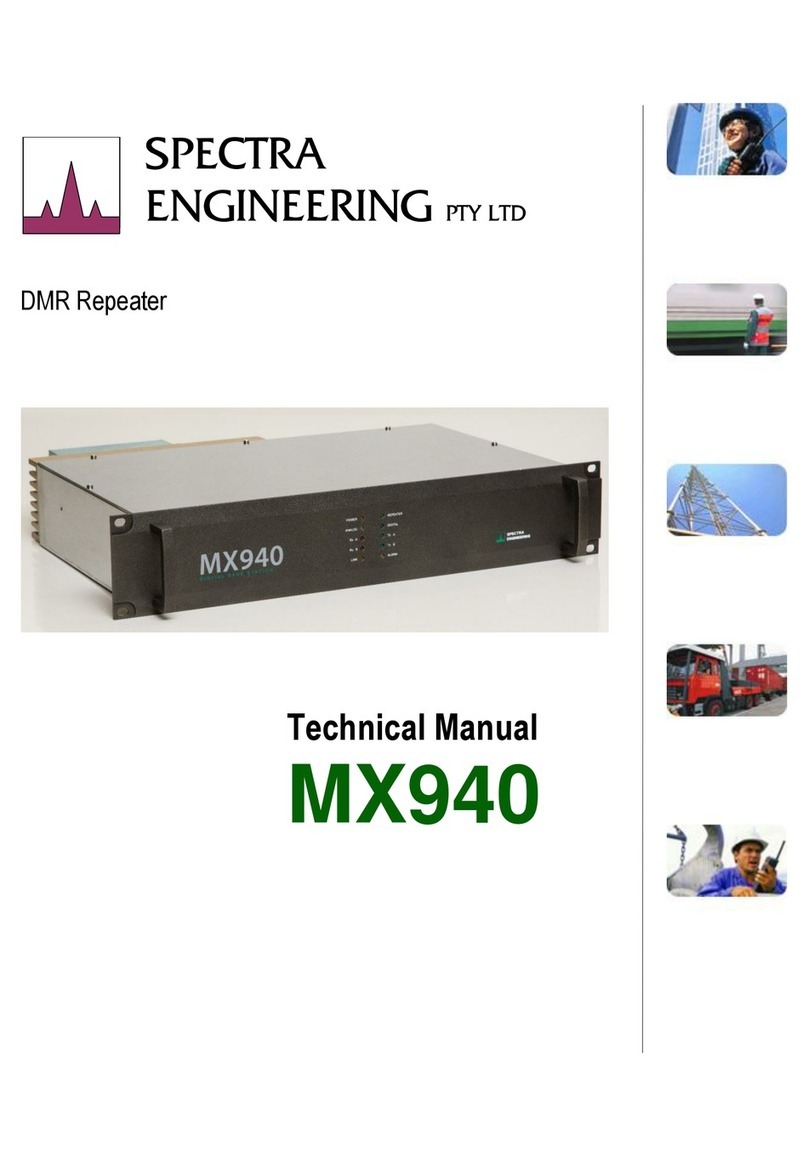
Spectra Engineering
Spectra Engineering MX940 Technical manual
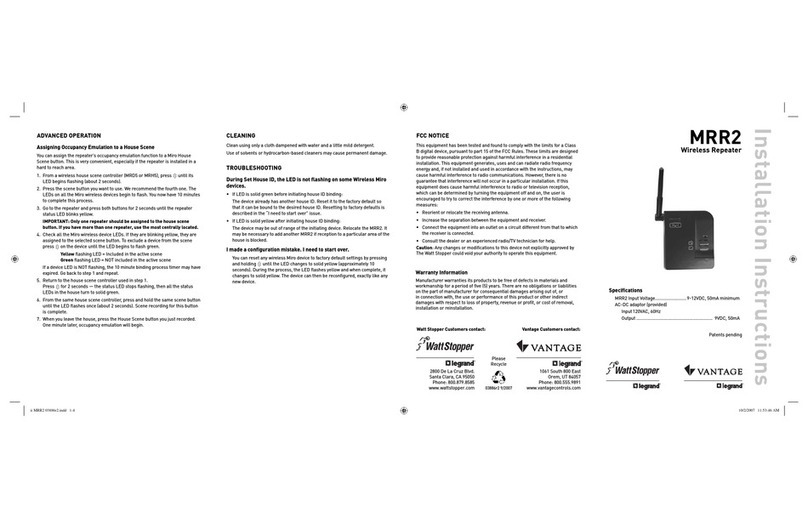
wattstopper
wattstopper MRR2 installation instructions

GM International
GM International D1130S Instruction & safety manual
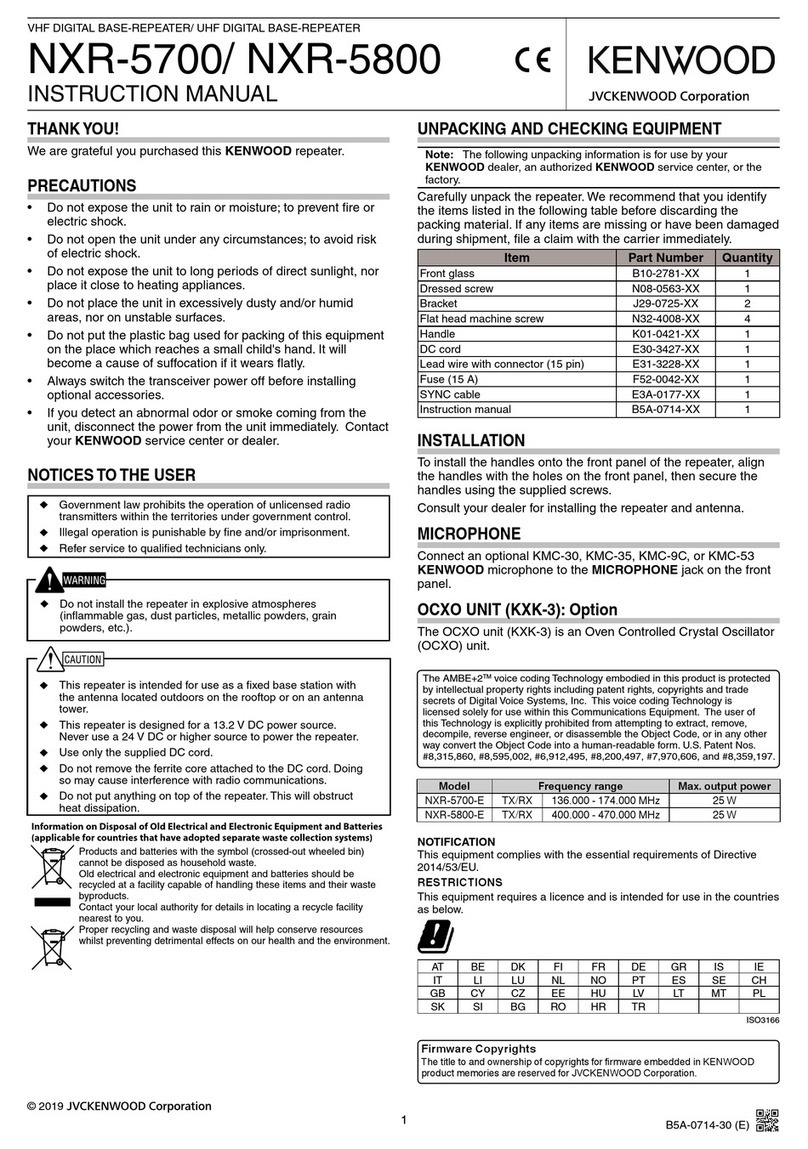
JVCKENWOOD
JVCKENWOOD NXR-5700 instruction manual
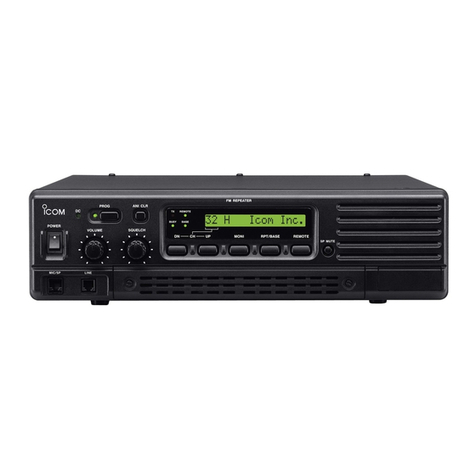
Icom
Icom IC-FR4000 Series Service manual

Siemens
Siemens Gigaset Repeater operating instructions
